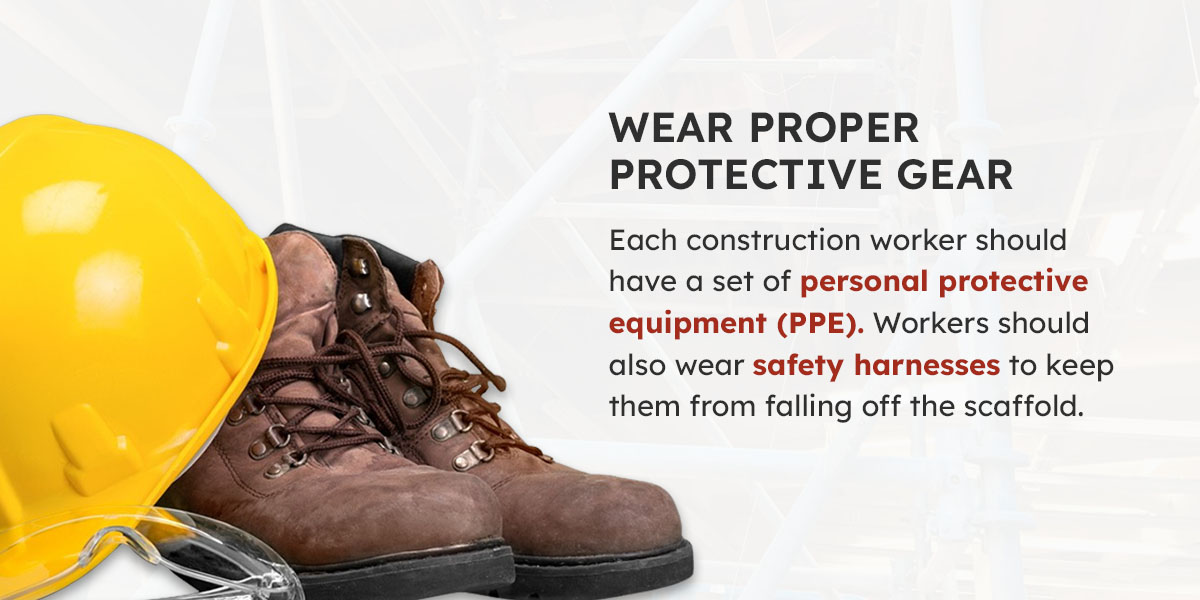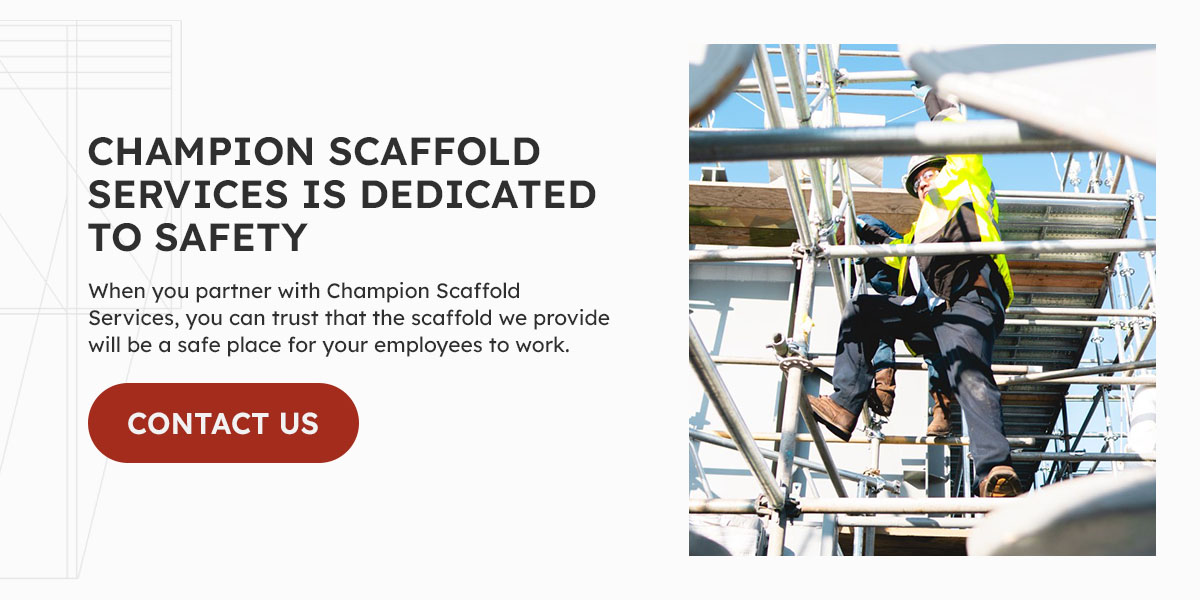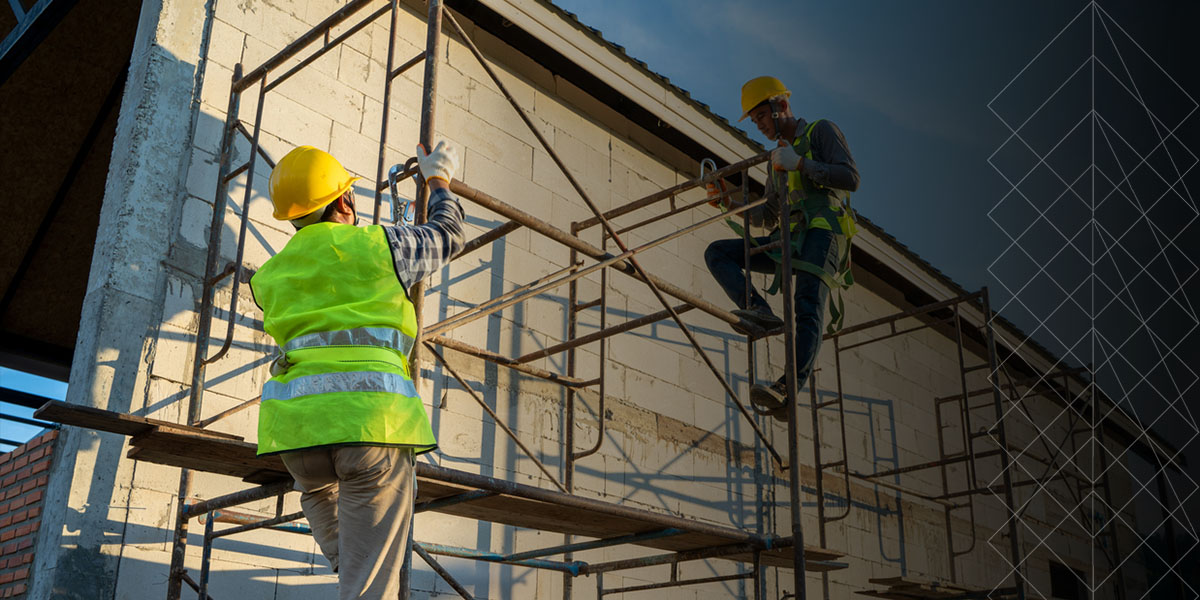While scaffold is tremendously helpful during construction, it can be dangerous if not erected properly and if workers don’t take safety precautions. We’ve compiled a list of construction scaffolding safety do’s and don’ts to help you and your crew stay safe as you work on sets of scaffold.
Why Is Scaffold Safety Important?
Falls are the leading cause of construction worker death, and many of those falls are from scaffold. OSHA estimates that millions of construction workers perform their duties while on scaffold The nature of scaffold means that each of these people is exposed to safety hazards, including falls, falling objects and electrocution.
Fortunately, workplace safety incidents are often preventable. Sets of scaffold that are built by trained installers and inspected by a safety professional allow construction workers to perform their duties with less risk. Undergoing training on safe work practices and wearing protective equipment is also essential for scaffold safety.
Scaffold Safety Do’s
Take the following scaffold safety precautions to ensure your job site is as safe as possible.
1. Get Trained on Safe Scaffold Use
A qualified teacher should provide scaffold safety training to workers before they use the scaffold. Training teaches workers how to identify electrocution, fall hazards and falling object risks, as well as the right way to deal with these situations if they arise. Training also covers proper scaffold use, material handling and load capacity.
2. Install Sets of Scaffold Properly
Only qualified builders, under the direction of a competent supervisor, should construct scaffold.
Qualified builders are those with an educational background in safe scaffold design. Trained scaffold engineers or professionals from a scaffold manufacturing company are considered qualified installers.
A competent person is someone with thorough training in safe job site practices. These people can identify existing and potential hazards and take action to eliminate them. Competent supervisors are often licensed in safe scaffold practices.
3. Inspect the Scaffold
Inspectors should survey scaffold before they’re built and at the beginning of each workday.
Installers should check their scaffold materials before they build to ensure there are no defects or damage that could undermine the scaffold’s structural integrity. Additionally, all components should come from the same manufacturer so they fit together properly.
A qualified inspector should use a scaffold safety checklist at the start of each shift to confirm the scaffold is safe and ready for use.
4. Mind the Weight Limits
Engineers design scaffold configurations and parts with specific weight-bearing capabilities in mind. Using a scaffold system rated to support the loads of your project is crucial for job site safety. Otherwise, scaffold components can crack, break or collapse, leading to serious injury to nearby workers.
5. Understand Regulations and Standards
OSHA sets forth a comprehensive set of construction industry regulations and standards to promote scaffold safety. Understanding and abiding by these regulations can help you prevent accidents and avoid liability for noncompliance. Keep in mind that rules can vary by state and even city, so refamiliarize yourself with your location’s standards regularly.
6. Use a Tagging System
Inspectors use tags to indicate a scaffold’s safety status:
- Green tags: Green tags identify the scaffold as safe for use.
- Yellow tags: Yellow tags mean the scaffold has been altered in some way to meet job requirements, and workers may be at risk.
- Red tags: Red tags indicate the scaffold is unsafe. You’ll typically see red tags during the installation or dismantling process.
Inspectors should place these tags close to the scaffold’s access point and at eye level.
7. Wear Proper Protective Gear
Each construction worker should have a set of personal protective equipment (PPE). PPE for scaffold safety includes the following:
- Hard hats
- Sturdy, nonskid work boots
- Tool lanyards
- High-visibility vests
Workers should also wear safety harnesses to keep them from falling off the scaffold.

8. Climb Safely
Workers who climb scaffold should do so properly. Responsible climbing means workers have three points of contact with the scaffold at all times — either one hand and two feet or two hands and one foot.
Additionally, workers should avoid climbing on certain parts of the scaffold not intended to support sheer weight, such as the cross braces. Scaffold safety training will teach workers which parts they should and shouldn’t use for climbing.
Scaffold Safety Don’ts
To ensure the safe use of scaffold, avoid the following potentially risky practices.
- Don’t use the scaffold if it looks damaged or tampered with: If you notice any missing or damaged parts such as planks, toeboards, guardrails, debris nets or safety canopies, alert your supervisor so they can fix the scaffold and have it inspected. Don’t attempt to repair or replace scaffold parts unless you’re trained to do so.
- Don’t exceed the scaffold’s weight limits: As we mentioned, engineers design scaffold to hold a certain weight safely. Everyone who uses the scaffold should know this number so they don’t overload it and run the risk of a dangerous accident.
- Don’t leave tools or materials on the scaffold after your shift: It’s important to clear the scaffold of tools and materials at the end of the workday. Unattended items can blow off the scaffold in the wind or pose a tripping hazard to oncoming workers.
- Don’t use ladders or boxes on top of scaffold: You may be tempted to use a ladder or other platform on top of the scaffold to access heights out of reach, but these are safety hazards. If you need to reach a higher area, have your supervisor raise the work platform.
- Don’t climb on any parts of the scaffold not intended for climbing: Do not scale the scaffold frame. Always access scaffold using a fixed or built-in ladder or an internal stairway. Also, avoid climbing with any tools or materials in hand — they can distract you or compromise safe climbing. Tools and materials should be hoisted onto the scaffold separately.
- Don’t walk or stand on compromised scaffold planking: Platforms covered in mud, snow, ice or wet leaves can be dangerous. Have these elements removed from the platform before beginning work. Additionally, it’s best to avoid using scaffold during inclement weather conditions, such as heavy rain, high winds, sleet, snow and ice.
Champion Scaffold Services Is Dedicated to Safety
At Champion Scaffold Services, we understand that safety is crucial when workers perform construction, maintenance or renovation projects at heights. We take the following measures to ensure safety is our top priority:
- Thoroughly train our staff
- Sponsor an apprentice and safety development program
- Offer additional worker protections, including handrails, netting and shrink wrap
When you partner with Champion Scaffold Services, you can trust that the scaffold we provide will be a safe place for your employees to work. Contact Champion Scaffold Services for a quote on safe solutions!




